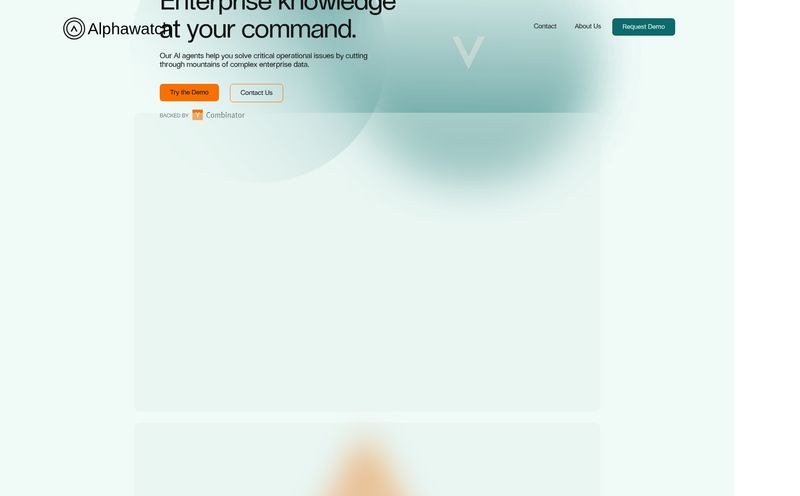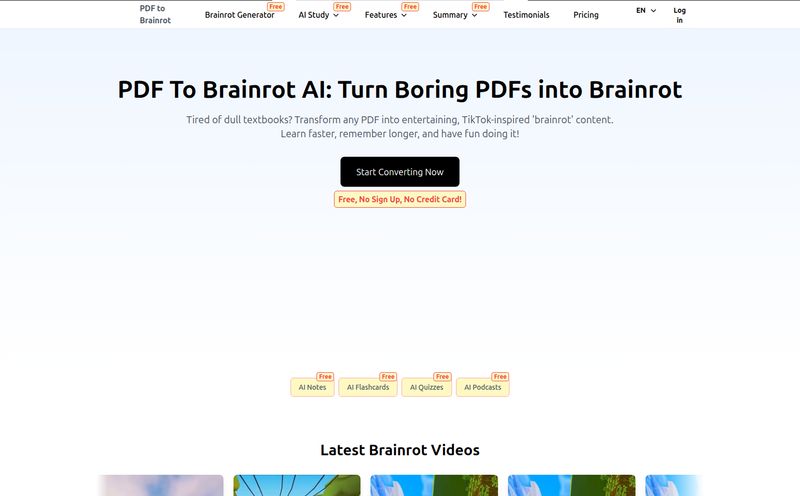If you've ever had to create a flowchart from scratch, you know the special kind of pain I'm talking about. The endless dragging of boxes. The fiddling with connector lines that refuse to snap into place. The slow descent into madness as you try to make everything in your PowerPoint or Google Slides presentation look... well, not like a plate of digital spaghetti.
I've been there. As an SEO, I live and breathe process maps, user flows, and content funnels. And honestly, I'd rather spend an afternoon analyzing SERP volatility than manually aligning a 20-step diagram. It's just tedious.
So when I stumbled upon a tool called Docugram, which claims to be an AI flowchart maker that turns plain text into diagrams, my interest was definitely piqued. A tool that does the boring part for me? Sign me up. But as we all know, a lot of AI tools promise the moon and deliver... a blurry picture of a rock. I had to see for myself if this was the real deal.

Visit Docugram
So, What Exactly is Docugram?
At its heart, Docugram is a translator. It takes the language of your documents, your hastily-written notes, or even just a simple text prompt and translates it into the visual language of a flowchart. You paste your text, click a button, and poof—a diagram appears.
It's built on a pretty simple idea: most processes can be described in a linear, step-by-step fashion. Why not let a machine handle the visual representation of those steps? Instead of you being the architect, builder, and interior designer of your diagram, Docugram acts as your super-fast construction crew. You just hand over the blueprints (your text), and it builds the structure. It’s a deceptively simple concept, but the execution is what matters.
Taking It For a Spin: The Good, The Fast, and The Surprisingly Smart
I decided to give the free Starter Plan a whirl. It gives you 5 free generations, which is more than enough to get a feel for things. I grabbed a chunk of text from a standard operating procedure I wrote for a client and pasted it in.
From Text to Diagram in Seconds
Okay, I wasn't expecting it to be that fast. It took maybe three seconds. The generated flowchart was clean, logical, and followed the steps from my document almost perfectly. There's a certain magic to seeing your own words instantly visualized. It felt less like using a tool and more like a collaboration.
I could immediately see how this would slash hours off my weekly workload. No more drawing boxes. No more connecting arrows. It just… works.
The Joy of the Auto-Layout Button
Even after the initial generation, you can still play around. The editor is pretty intuitive. You can change text, add or delete nodes, and customize shapes and colors. But the real star of the show for me is the automatic layout feature. If you move a few things around and your diagram starts looking messy, you hit one button and it tidies everything up for you. It’s like a little Roomba for your messy workflow diagrams. It’s a small thing, but it shows they understand the real-world frustration of keeping complex charts aligned.
Let’s Talk About the Price Tag
This is where things get interesting. Docugram has a straightforward pricing model that I actually appreciate. No hidden fees or confusing tiers.
Here's a quick breakdown:
| Plan | Cost | Key Features |
|---|---|---|
| Starter | $0 / forever | 5 document-to-diagram generations, unlimited editor access, local saving. Perfect for a test drive. |
| Pro | $7.50 / month (or $3/mo if paid yearly) | Unlimited generations, priority support, and a bunch of features listed as 'Coming Soon'. |
The Starter Plan is genuinely useful. It’s not one of those crippled free plans where you can't do anything. Being able to save your files locally is a huge plus for data privacy and control. You can create a few charts, edit them to your heart's content, and save them without paying a dime.
The Pro Plan is where the power users will land. The jump to unlimited generations is the main draw right now. At $3/month on the yearly plan, it's cheaper than my daily coffee. That's a pretty low barrier to entry for a tool that could save you a significant amount of time. One of the user testimonials from a certain Sophie Dubois on their site says the Pro plan is a "steal", and I'm inclined to agree.
The Catch: A Few 'Coming Soon' Caveats
Now, I wouldn’t be doing my job if I didn’t point out the slightly less-shiny parts. As of right now, several key features for the Pro plan are still in development. These include:
- Custom templates and themes
- Exporting diagrams in multiple formats (like PNG or SVG)
- Real-time collaboration
This is the classic startup dilema, isn't it? You're buying into the tool's current functionality and its future promise. The lack of varied export options is probably the biggest hurdle for immediate professional use. You can save the file, but you can't easily pop it into a presentation just yet. And real-time collaboration is the gold standard for team-based tools these days. The good news is, they're upfront about it. The price reflects that it's a growing platform, and getting in early could be a smart move, especially if those features roll out soon.
So, Who is Docugram Actually For?
After playing around with it, I can see a few groups of people who would absolutely love this.
- Project Managers & Consultants: To quickly visualize project plans, workflows, and business processes without getting bogged down in diagramming software.
- Content Creators & SEOs: For mapping out content funnels, topic clusters, or user journeys. I've already used it to sketch out a new site architecture.
- Students & Educators: A fantastic way to turn lecture notes or research papers into easy-to-understand visual aids. Way better than just rereading highlighted text.
- Developers: To quickly map out application logic or user flows from technical documentation before writing a single line of code.
Essentially, if you're someone who thinks in processes and needs to communicate those processes to others, Docugram is worth a look. It removes the friction between the idea in your head and the diagram on your screen.
Frequently Asked Questions About Docugram
- Is Docugram really free to use?
- Yes, the Starter Plan is free forever. It gives you 5 AI generations to convert text to diagrams, but you get unlimited access to the diagram editor and can save your work locally.
- Can I edit the flowcharts after they're generated?
- Absolutely. You have full control. You can edit the text in each node, change colors and shapes, add new nodes, delete ones you don't need, and rearrange everything. The auto-layout feature is a lifesaver for tidying up your edits.
- What's the main reason to upgrade to the Pro plan?
- The biggest reason right now is unlimited document-to-diagram generations. If you plan on using this for more than just a couple of one-off projects, you'll hit the 5-generation limit on the free plan pretty fast. You're also investing in the upcoming features like exports and collaboration.
- How does this compare to something like Miro or Lucidchart?
- It's a different beast. Tools like Miro and Lucidchart are powerful, collaborative digital whiteboards. They can do everything. Docugram is much more focused. Its superpower is the initial AI generation from text. It’s not trying to be a do-it-all whiteboard; it’s trying to be the fastest way to get a solid, workable flowchart started. You might even start in Docugram and, for now, manually recreate it in a bigger tool for collaboration.
- Can I export my diagrams to use in reports or presentations?
- Not yet, but this feature is listed as 'Coming Soon' for Pro users. For now, you can save the Docugram file itself to your computer, but not as an image file like a PNG or JPG.
Final Thoughts: Is Docugram Worth Your Time?
I gotta admit, I'm pretty impressed. Docugram tackles a very specific, very annoying problem and solves it with elegance. It’s not a bloated, feature-packed behemoth. It's a sharp, focused tool that does one thing exceptionally well: it saves you time by turning your thoughts into visuals.
Yes, it's still a young platform. You're betting on the 'Coming Soon' features. But the foundation is incredibly solid, and the free plan is generous enough that there's literally no risk in trying it. For the sheer speed and convenience, it's already earned a spot in my digital toolbox. It's a fantastic first-draft machine that gets you 90% of the way there in 1% of the time. And in the world of SEO and digital marketing, that's a win I'll take any day of the week.



